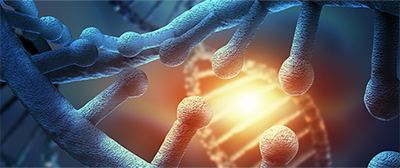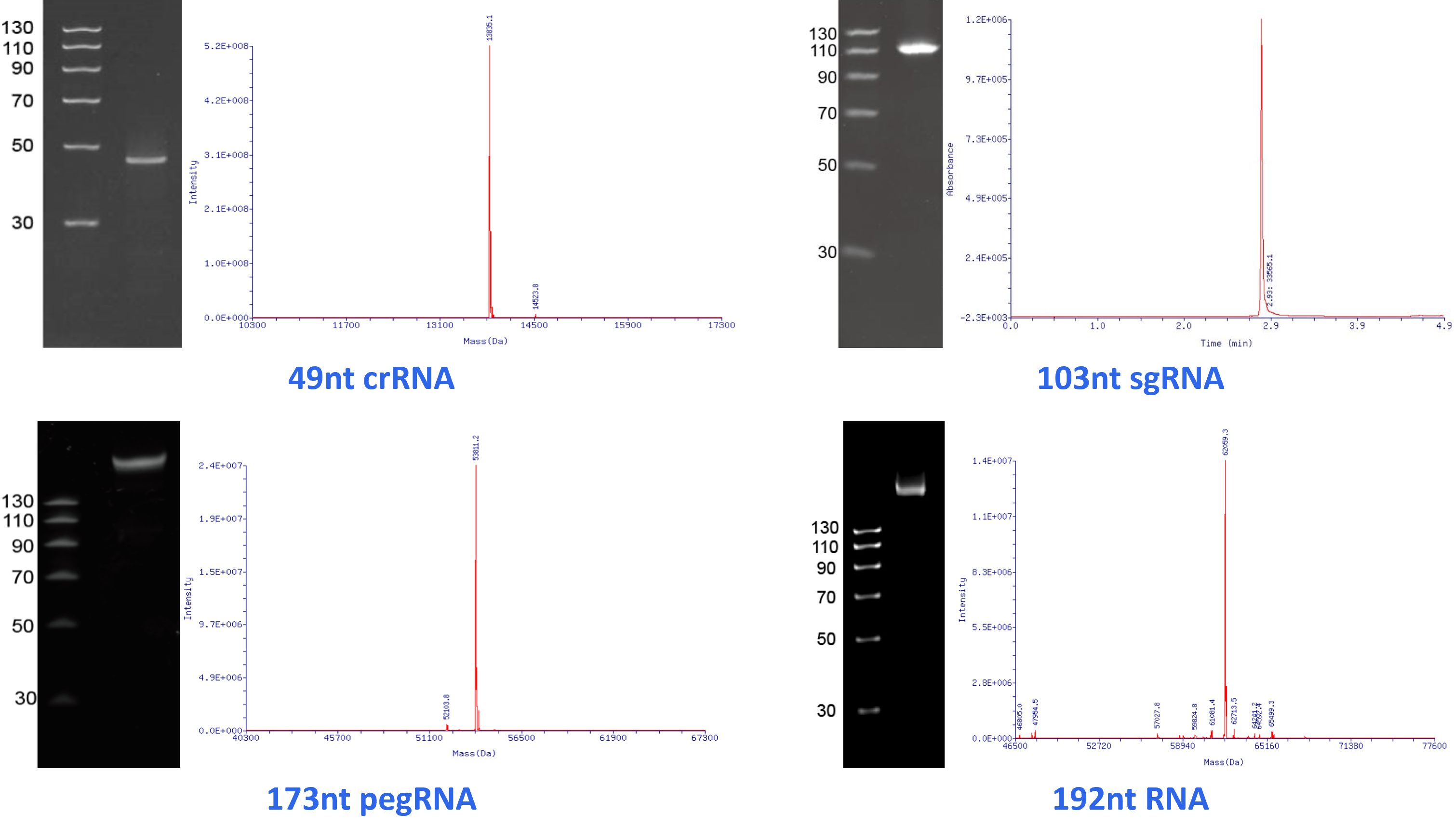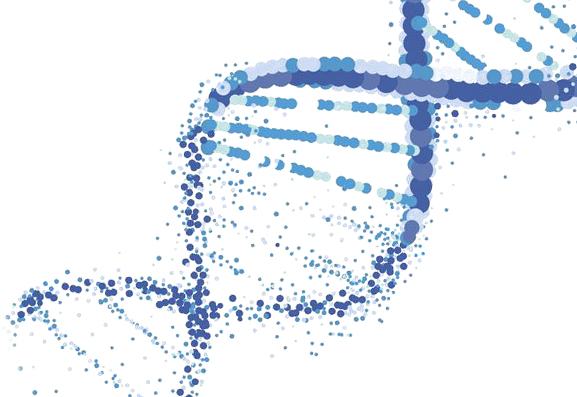Welcome to order our products!
You can easily and quickly purchase the products you need through our online store.

crRNA Synthesis
Product Introduction:The guide RNA used in the Cas12a system—crRNA, is approximately 40-44 nt in length. It forms a complex with the Cas12a protein to target specific sites for gene editing or in vitro diagnostics.
Product Features:Offers AsCas12a and LbCas12a, supports other customized crRNA synthesis, ensures high purity and accurate molecular weight for reliable gene knockout and knock-in experiments.
| Product | Length | Modification | Purification | Production Cycle | Price |
| Cas12a crRNA | 40-44nt |
Default m and * modifications Customizable modifications available |
Desalted | From 5 business days | Contact us for pricing |
| HPLC |
1、2'-O-Methylation(m),Thio(*)modifications are included at no extra charge. Other custom modifications are available upon request.
2、AsCas12a and LbCas12a can be provided with only the spacer sequence. We offer validated modification combinations for free. Please contact us for details.
3、For other Cas12a, please provide the complete 40-44 nt sequence.
sgRNA Synthesis
Product Introduction:Our sgRNA is specifically designed for the CRISPR Cas9 system, with a length of approximately 97-103 nt, optimized for high stability and performance.
Product Features:
- High Stability: Each sgRNA includes m and * modifications at the first 3 and last 3 nt, as reported in literature to enhance stability and efficiency.
- High Efficiency and Safety: Utilizing RNP complexes (Cas9 protein + sgRNA) further improves editing efficiency, reduces off-target effects, and ensures safety.
| Product | Length | Modification | Purification | Production Cycle | Price |
| sgRNA | 97-103nt |
Default m and * modifications Customizable modifications available |
Desalted | From 5 business days | Contact us for pricing |
| HPLC | From 7 business days |
1、Default m and * modifications are included at no charge. Other custom modifications are available upon request.
pegRNA Synthesis
Product Introduction:Prime editing guide RNA—pegRNA, is a revolutionary gene editing technology that enables precise single-base editing and larger insertions. Our pegRNA products can be up to 230 nt in length, designed with precision and high reliability.
Product Features:
- High Purity and Accuracy: Produced using our advanced nMECA platform, pegRNA ensures high purity and accurate molecular weight, guaranteeing consistent prime editing results.
- Widely Trusted: Our pegRNA is renowned for its high quality and reliability, highly recognized by researchers worldwide.
| Product | Length | Modification | Purification | Production Cycle | Price |
| pegRNA | 110-230nt | Customizable modifications available | Desalted | From 10 business days | Contact us for pricing |
| HPLC |
1、Default m and * modifications are included at no charge. Other custom modifications are available upon request.
2、We recommend HPLC purification to ensure higher RNA quality and improved editing efficiency.
Custom RNA Longmer Synthesis
Product Introduction:Using our proprietary nMECA platform, we provide high-quality RNA longmer synthesis services, including the mRNA, guide RNA for novel editing tools, and various types of long non-coding RNA (lncRNA). We not only meet your needs for RNA longmer synthesis but also offer site-specific modifications.
Features of RNA Longmer Product:
- High Quality: All products undergo rigorous quality control to ensure high-quality RNA.
- High purity: HPLC purification reduces residual impurities, enhancing RNA quality.
- Site-Specific Modification: We offer targeted modifications to meet the diverse research needs of our clients.
| Product | Length | Modification | Purification | Production Cycle | Price |
| RNA Longmer | 230-400nt | Customizable modifications available | HPLC | From 20 business days | Contact us for pricing |
1、Default m and * modifications are included at no charge. Other custom modifications are available upon request.
2、If you have any questions regarding our RNA longmer synthesis services, feel free to contact us by email or submit an inquiry (order@pixelbiosciences.com), and we will provide you with a comprehensive solution.
The field of genome editing has seen the emergence of several advanced tools, including Prime Editor, Base Editor, and Fanzor, all of which are remarkable technologies. They enable precise DNA modifications within the genome, holding immense potential for fields like scientific research, biomedicine, and agriculture.

Gene function research: sgRNA aids in uncovering gene function and regulatory mechanisms through gene knockout, introduction of mutations, and modification.

Gene function research: sgRNA aids in uncovering gene function and regulatory mechanisms through gene knockout, introduction of mutations, and modification.
Combined with activators or repressors, sgRNA enables precise regulation of gene expression and the study of gene regulatory networks.

Combined with activators or repressors, sgRNA enables precise regulation of gene expression and the study of gene regulatory networks.
CRISPR-Cas9 and sgRNA facilitate the introduction of site-specific mutations to mimic disease-associated mutations and studying their effects.

CRISPR-Cas9 and sgRNA facilitate the introduction of site-specific mutations to mimic disease-associated mutations and studying their effects.
sgRNA allows the creation of knockout libraries and genome editing libraries, enabling efficient and high-throughput screening linked to specific functions or diseases.

sgRNA allows the creation of knockout libraries and genome editing libraries, enabling efficient and high-throughput screening linked to specific functions or diseases.
sgRNA typically consists of 97 to 101 nucleotides and some customized sgRNA lengths can be extended to 120-300 nt or even longer. We provide the flexibility to tailor the RNA length according to your experimental requirements.
Our high purity and modified sgRNA ensure rapid and accurate recognition and cleavage of target DNA sequences, maintaining stability and low immunogenicity within the cells, thereby guaranteeing efficient gene editing or gene knockout.
sgRNA can be utilized in various cell types and organisms, including mammals, plants, and microorganisms, and offer a broad range of applications for diverse research areas.
Strategic design of the sgRNA sequence enables precise guidance of the CRISPR-Cas9 system to target gene sequences, achieving accurate gene editing and regulation.
Through our exclusive enzymatic labeling nMECA technology, we offer competitive prices for sgRNA products, reducing experimental costs for researchers.



